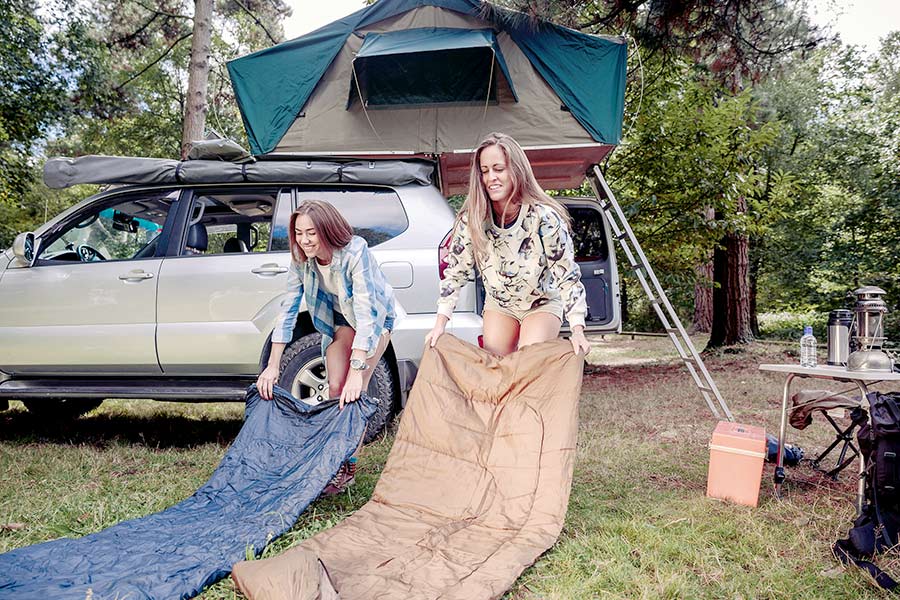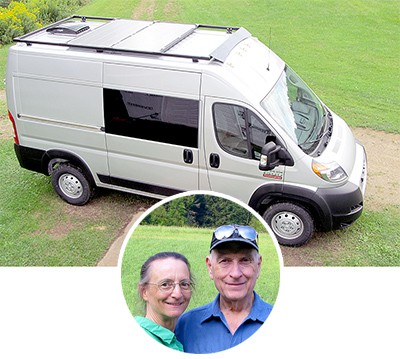
For many who don’t camp in one spot for long, a rooftop tent might be a suitable solution. You may find it classic and traditional to camp on the ground; however, in scenarios such as overnight sleeping while traveling or a period of inclement weather, a rooftop tent could be a perfect alternative.
Can my car support a rooftop tent? Yes, your vehicle can support a rooftop tent, as long as the rooftop load limit is over 165-pounds. Many SUVs, trucks, and larger automobiles will be ideal for this, but smaller cars and sedans may not have a structural capacity to support a rooftop tent, rack system, and the campers themselves.
Imagine never having to find suitable-terrain for a campsite again or worrying about external factors out of your control, such as meddlesome animals and muddy-soil. If you are on the go, a rooftop tent would be a great addition to your pack-list. Use this quick read to understand feasibility, installation, and some ideal rooftop tent models to consider.
Can Your Car’s Roof Support You?
The car’s ability to support your group will all depend on the type of vehicle you have. Any addition to your roof may alter your vehicle’s center of gravity and affect the vehicle’s stability.
To know if your car is feasible for a rooftop tent. You will have to look up your specific car model as there are too many to cover here. However, as a basic rule of thumb:
- Cars may not be strong enough to support the entire rack and the tent base, but this will depend on their weight class for rooftop limits, unique to each model and brand.
- Trucks and large SUVs will often be strong enough to support the entire rack and tent base.
How Much Does a Rooftop Tent Weigh?
A rooftop tent can easily weigh 200-pounds or more when accounting for the metal rack that serves as a base. Generally, the weight-classes for your rooftop tent will be 200-pounds per camper, so:
- A 2-person tent can handle upwards of 400-pounds
- A 3-person tent can handle 600-pounds, etc.
Related Posts
- Camping With Blankets Instead Of Sleeping Bags: Here’s How
- 20 Ways to Repel Bugs When Camping
- Why Are Sleeping Bags So Slippery?
- How Do You Choose the Right Campground for Van Camping?
Warnings Against Exceeding Your Rooftop Structural Weight Limit
Even while driving with the rooftop tent, you will feel a change in your ability to control the vehicle. Meaning, you may sense a bit of a side-ways lean or pull that needs to be counteracted by your control over the steering wheel.
Below are a few reasons that you must consider the recommended weight requirements. If you put more weight on the roof than your vehicle can support, this can:
- Negatively influence vehicle stability.
- Reduce your control over the vehicle.
- Could potentially reduce gas mileage.
- Add increased wear to the suspension system.
- Extra weight could reduce the ability to accelerate quickly.
- Increase the risk of roof damage.
If your rooftop load limit is under 165-pounds – Do not attempt to place a rooftop tent on it.
Considerations to Make While Shopping
A few crucial factors to consider while you’re determining the right rooftop tent for your lifestyle and vehicle are:
- Rooftop capacity for weight.
- Weight of the people camping.
- Weight of the rack-base and ladder.
- Weight of the tent itself.
These together are referred to as the combined static weight.
Leave some cushion room, meaning if the car can only support 300-pounds, don’t put 299-pounds on it. Aim low and don’t push the boundaries, or you’ll risk denting your rooftop into a downwards slump.
Confirm before purchasing that the tent you like is compatible with your vehicle model.
Consider amenities or specificities that you may enjoy from your rooftop tent, such as:
- Hard-top or metal tent, ideal for freezing temperatures or if your belongings need more security.
- Durability, you can find a more rugged one or go all the way to the other end of the spectrum with a mesh-tent.
- Awnings & Extensions, some rooftop tents will allow you the option of extending your space beyond the square footage of your vehicle’s rooftop. Almost like a balcony that extends beyond your car. If you want a homey set-up or you’re living the wanderer-lifestyle, the extra room might be ideal.
A few excellent rooftop tent options to check-out that suit most vehicles and models are:
- Thule – The Tepui rooftop tent has a low profile and can sleep up to two people. When folded down, it is only 7 inches high, which gives you excellent aerodynamics when on the road traveling. Thule also has a version that sleeps 3.
- Overland Vehicle Systems – The Nomadic 2 extended rooftop tent is constructed from marine grade rip-stop polyester-cotton canvas. The body and rainfly are both waterproof. It has a telescoping ladder, storage pockets and requires no drilling as it attaches to your existing roof rack.
- Raptor Series – The Voyager will easily mount to your roof rack and sets up quickly. You can access the tent with the eight-foot telescoping ladder, and it also features storage pockets, air vents, and a built-in awning. It is designed to withstand heavy winds, and the maximum load is 750 pounds.
We have a couple of related posts that tell you how to pack a 4×4 and the benefits of using a mattress topper for camping, and we hope you enjoy them.
How to Install Your Rooftop Tent
It’s a straightforward process to install your rooftop tent, but you cannot merely place it up there and expect it to stay put. The preliminary steps you will take are:
- Determine the rooftop weight limit of your vehicle, simply look it up or call the dealership to determine what weight limit your car has.
- Do the math on how many people, speed, and any additional factors that will decrease the amount of wiggle-room you have for extra belongings.
- Purchase a compatible rooftop tent that is suited to your vehicle type. Ask for help from the salesperson if you have any questions, and they can direct you based on your car model and rooftop weight limit.
- Confirm that your base has a DWC (Dynamic Weight Capacity) that can sustain the weight of your tent and belongings.
- Build the base by installing it on a canopy, crossbars, or flat racks.
- Determine if you have crossbars or side-railing also consider if you’re building the awning that will extend off the side or from the back of your vehicle.
- Attach the base to your tent. Do this by connecting the mounting tracks parallel to the tent hinge. Keep everything upside down for now so that you are working on the part which will attach directly to your rooftop.
- Align the holes in the mounting tracks with the holes in the base.
- Insert all the bolts into the pre-drilled holes which you’ve already aligned and attach the nuts.
- Tighten and flip the tent over so that you are now seeing the top of the tent.
- Add bolts and nuts for the ladder bracket.
- Once the ladder is attached, you can zip up your tent in its portable case or waterproof bag.
- Have someone assist you in carrying the tent to the top of your vehicle and safely placing it on top.
- Make sure that the vehicle mounting tracks are perpendicular to the bars on your roof rack.
- Now slide the roof rack bars into the channel sliders made of aluminum. Slide each bolt onto either end of the roof rack bar.
- Repeat this for every corner of your tent until it is secured firmly into place. Attempt to slide it around and mimic a real-driving scenario where terrains, potholes, and speed will influence your rooftop tent’s security.
Always utilize your specific model’s manual and instructions based on your own unique kit. Each rooftop tent and base installation will vary slightly in installation processes.
Why You Should Have a Rooftop Tent
Many people have not heard of a rooftop tent as they are more common in Australia and overseas. It became popular in Australia because of the many insects and multi-legged creatures roaming around the outback. Campers decided that they needed a more protected place to sleep through the night.
There are many benefits to consider if you are a camper and the reasons to invest in a rooftop tent are:
- Frees up storage space in your vehicle, consider how much room a camping set-up typically takes up.
- You don’t have to sleep on uneven ground, roots, twigs, gravel, bumpy terrain, or any scenario where you don’t have a mattress.
- You remain dry from muddy-soil and saved from the effects of rain, snow, sleet, and any weather condition that could leave you soaked from below.
- No more struggle to set-up a tent at each camping location. Only a simple unzipping instead of the many poles and pegs.
- No more wasting time looking for the ideal camping site, it’s always with to you.
- Less worry about critters with an elevation between you and any nocturnal creatures such as foxes, coyotes, bears, snakes, etc.
- You can usually get a larger tent because it doesn’t have to be carried or transported.
- You get a calmer and safer feeling of being elevated for a more restful night’s sleep.
In Conclusion
Most cars will have a rooftop weight limit of 165-pounds, which won’t be strong enough to place a rooftop tent or people on the top.
Larger trucks and heavy-duty SUVs such as Jeeps are often strong enough to support a rooftop tent set-up.
Overall, these are easier than traditional tents, and it will be set-up for you at each new stop. Check your weight class and determine with your dealer or online research if your vehicle is sturdy enough to install a rooftop tent.
Your home will be built and ready-to-go – leaving you with more time to relish in your adventures.






